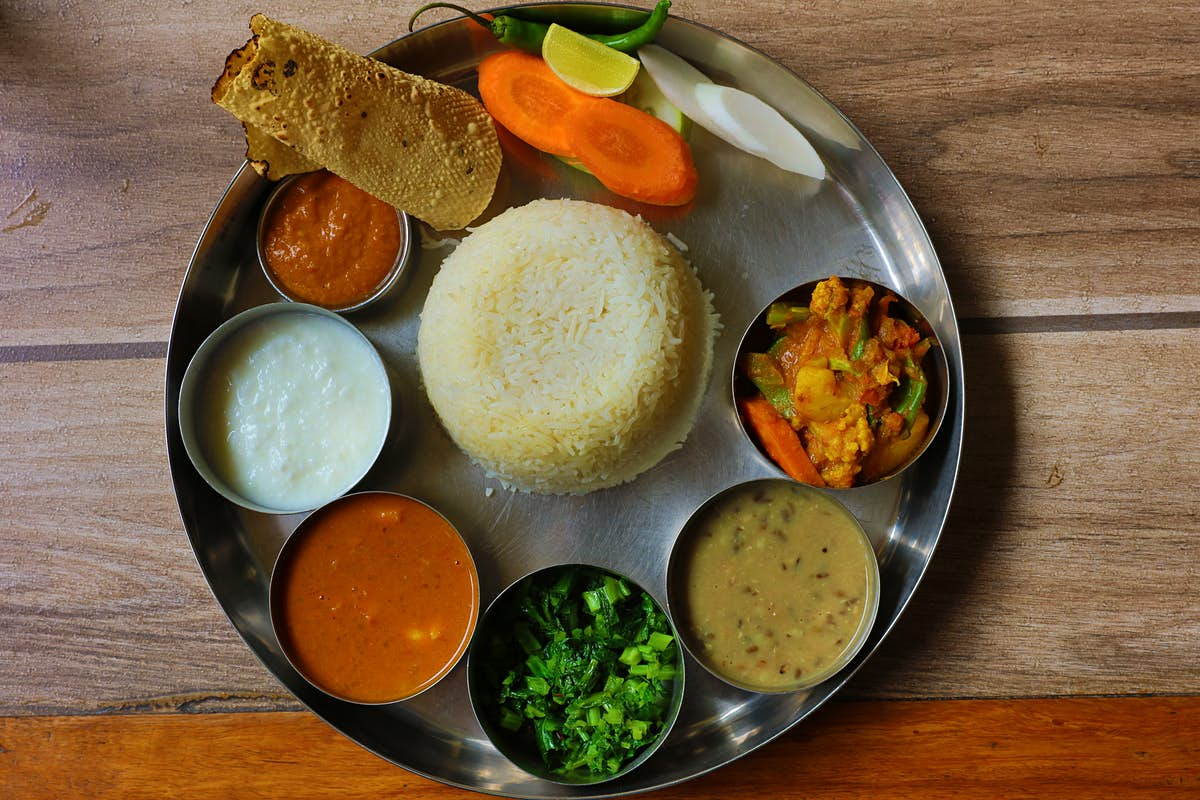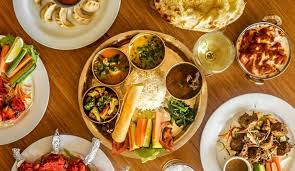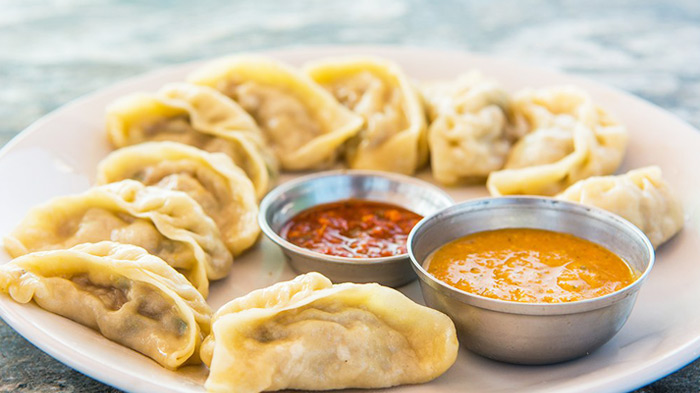Differences between Indian and Nepalese cuisine

For decades, I’ve been a fan of Indian cuisine. I’ve recently become aware of Nepalese cuisine and have wondered what the differences are between Indian and Nepalese cuisine.
Here’s what I discovered:
Nepal shares borders with India, Tibet, and China; therefore, all three countries have culinary influences. Spicy curry, turmeric, flatbreads, and rice are all favorites in India and Nepal. However, unlike Indian cuisine, Nepalese cuisine does not utilize cream and uses sugar sparingly, and is typically regarded as healthier than Indian cuisine.
But there’s a lot more to learn about each of these incredible places’ cuisines.
So today, we’re going cultural and looking at the food in both of these locations. We’ll look at some of the significant distinctions. But we’ll look at the similarities as well as if one is healthier than the other.
We’re trying to figure out what the difference is between Indian and Nepalese cuisine.
Let’s get started!
What is traditional Nepalese cuisine, and how does it differ from Indian cuisine?

Nepal is a melting pot of cuisines, drawing on Tibetan, Indian, Chinese, and other Asian influences.
Nepalese cuisine, like Indian cuisine, uses the following herbs and spices in many of its dishes:
- Chile peppers
- turmeric
- Cilantro
- garlic
- ginger
And their famous Momo Masala spice blend includes the following ingredients, many of which are widely used in Indian cooking:
Cumin, Cloves, Cinnamon, Onion, Garlic, Dry Ginger, Turmeric, Red Chillies, Fenugreek, Mustard, Coriander, Cardamom, Cumin, Cloves, Cinnamon, Onion, Garlic, Dry Ginger, Turmeric, Red Chillies, Fenugreek, Mustard, Coriander.
Like most Asian countries, Nepal is a rice-heavy country, with pulao (fried rice) being a popular dish. Pulao is frequently served with yogurt and papadums, just like rice dishes are in India.
Lentils, potatoes, and tomatoes are also famous in Nepal, as they are in India, and Nepalis, like Indians, enjoy chutneys as a side dish. Both countries are also well-known for their ghee-based cuisine (clarified butter).
The Nepali love Thukpa, a chicken noodle soup variation, is one of the significant differences between the two cuisines (which can also be made with other meats or vegetarian).
Another area where they vary is with a dish called Dido, or Dheedo, which is cooked from buckwheat flour and has the consistency of oatmeal or grits (which is naturally gluten-free despite the name).
Of course, because Nepal is so close to India, you’ll get classic Indian cuisine there as well.
Is there a similarity between Nepal and India?
No. Nepal shares a border with India. So, despite their proximity, they are two distinct countries. While the majority of Nepalis are Hindu, they are not vegetarians like their Indian counterparts.
Mount Everest, the world’s highest peak, is also located there. The capital is Kathmandu.
Contrary to common misconceptions, vegetarianism is not a requirement of Hinduism. Vegetarianism has gained popularity in Hinduism due to the religion’s emphasis on avoiding harming other living things.
As a result, unlike many other parts of India, Nepalese people eat chicken and bison.
In truth, Hinduism is practiced by 80% of Nepalis, which is nearly identical to Hinduism in India. Nepal differs from India in terms of religion in that just roughly 2.5 percent of the population is Muslim, compared to 14 percent in India. In Nepal, Buddhism is practiced by approximately 8.5 percent of the population, compared to only a few percent in India.
Nepal is, on the whole, an impoverished, mountainous country with bad roads and frequent power outages. In Kathmandu and Pokhara, power disruptions are less common.
In terms of culture, Nepal resembles other Asian countries to the east and is less prone to furious outbursts than India.
What is Nepal’s most well-known dish?

Daal Bhat tarkari, a sort of lentil soup; Momo, a form of soup dumpling that can be steamed or fried, Dido, or Dheedo, a type of buckwheat oatmeal, and Chatamari, a type of pizza-like flatbread made from rice flour, are among Nepal’s most popular cuisines.
You may expect a lot of rice dishes, curries, and a few unexpected twists, just like Indian food.
The “comida tipica” of Nepal is dal bhat tarkari. Daal refers to lentils, split peas, and occasionally beans, as it does in India. The lentil, on the other hand, is the most frequent. Daal Bhat tarkari is a lentil-based soup with various spices, and it’s often served with Bhat, a boiled grain.
Different veggies, spices, and curry powder are used for cooking the lentils. Nepalese people are known to consume this dish twice a day.
I mentioned the Momo Masala spice combination before, and it’s a component of the most well-known meal, Momo.
This is a dumpling that looks a lot like the soup dumplings you could find at a dim sum restaurant.
The dough is filled with a mixture of buffalo meat, chicken, pork, and veggies. Steamed or fried, they’re similar to Chinese potstickers. This meal may be found in almost every restaurant in Nepal, and it’s usually served as an appetizer.
Apart from the Dheedo above, Chatamari is undoubtedly the most well-known Nepali cuisine.
This is specifically from the Newari people, who are the Kathmandu Valley’s aboriginal people. I’m not going to lie to you. This resembles a pizza in appearance, and it’s frequently served as an appetizer, just like Momo.
It’s a rice flour-based flatbread (much, but not all Nepalese cuisine would be naturally gluten-free). It’s usually topped with finely minced meat, eggs, and more familiar toppings like tomato, onions, and chili peppers, rather than mozzarella and tomato sauce.
What is India’s most famous dish?
The following are some of the most popular Indian dishes:
- Chaat - This Indian snack, which is essentially the Indian version of street cuisine, is a staple item across the country, albeit with various regional variations. It usually starts with fried, crispy bread or crackers covered with chutney, then a variety of toppings such as fried potatoes, sliced onion, or tomato.
- Matar Paneer - Paneer is a delectable Indian cheese with a very similar texture tofu cubes. In a rich tomato gravy, paneer refers to peas, and the two are blended. Northern India has a higher prevalence of this condition.
- Dosa - An Indian crepe composed of fermented rice and lentil flour batter, this Southern Indian staple is commonly eaten for breakfast in India. Still, it’s not uncommon to have it stuffed with tasty turmeric potatoes and served with chutneys as well.
- Biryani - A type of fried rice dish prepared in various ways that are often the centerpiece of dinner or the meal itself in many parts of India. Basmati rice is mixed with seasoned yogurt, whole spices, and chicken or goat meat (or vegetarian).
- Rogan Josh - Chunks of lamb (or mutton) are braised in a thick gravy prepared with ginger, garlic, onion, yogurt, and spices. The red color comes from red chilies, but the seeds are removed for a milder flavor.
- Butter Chicken — This Northern Indian favorite resembles chicken tikka masala, a dish that most Americans are familiar with. Chicken chunks are marinated in spices and yogurt before being cooked in a thick tomato sauce with lots of creams.
Of course, India is much larger than Nepal, and that vastness brings a diverse range of customs, cultures, and cuisines.
It’s usually in the United States to conceive of Northern and Southern Indian cuisine, but that’s an oversimplification.
I’ve been a fan for decades, and my brother has lived in India twice. I’ve also been preparing Indian food for more than 20 years, so I’m no stranger to the cuisine.
It’s also worth noting that different sections of India use distinct terminology and spellings for some of the same objects. For example, in the north, spinach is referred to as “palak,” whereas in the south, it is referred to as “saag.”
However, if we generalize a little and combine some of the various cultural influences from across the country, a few meals stand out.
If you want to cook Indian food, you probably already know that a food processor is a must-have!
Do Nepalese people consume beef?
No, in most cases. Nepalese people do not commonly consume beef, and cows are revered in Nepal, as they are in many regions of India.
The cow is Nepal’s national animal.
Cow slaughter is prohibited in Hinduism, the prevalent religion in both Nepal and India, and it does not prevent them from eating them. And, while the government is ostensibly secular, changing religions is prohibited.
As a result, it’s a bit of a grey area.
That may sound like a shady legal argument, but Hinduism encourages people to seek out and follow their paths. So, while it’s uncommon, some Nepalese do consume beef, and I also regularly notice one or two beef dishes at the Indian restaurant where I eat in Austin, TX.
Lamb and chicken, as in India, are the most popular meats in Nepal.
Some Nepalese ethnic groups, such as the Newars, Magars, and Tamangs, eat buffalo. Chris and Gurungs, on the other hand, do not eat buffalo meat.
All of this means that most Nepalis do not eat beef, and no one slaughters it.
However, imported beef can be found on the shelves of grocery shops in major cities and some restaurants and hotels.
Because of its proximity to China, Nepalese cuisine shares certain similarities with Chinese cuisine but also differs significantly.
Is Nepalese cuisine more nutritious than Indian cuisine?
Yes, in the broadest sense. Nepalese cuisine is thought to be lighter and healthier than Indian cuisine.
In reality, Nepalese cuisine is generally healthier than that of the rest of South Asia. Fresh vegetables, leaner meats, and leafy greens are frequently used instead of cooking oil by the Nepali.
Here are some of the significant differences between Nepalese and Indian cuisine that make Nepalese food healthier:
The cream is not used in Nepalese cuisine.

Nepalese people eat a lot less bread, such as naan or chapati.
Sugar or other sweets are nearly never used in Nepalese cooking.
It’s also worth mentioning that, in most cases, veggies are prepared using solely fresh herbs and dried spices rather than pastes, as is the case in some parts of India (and other Asian countries).
Did I answer all of your questions about the differences between Indian and Nepalese cuisine?
I looked into the worlds of Indian and Nepalese cuisine in this post.
We looked at some of the parallels as well as the main contrasts. However, we also considered which is the healthier option, even if Nepalese cuisine occasionally includes beef.
Finally, we addressed the subject of what distinguishes Indian and Nepalese cuisine.











